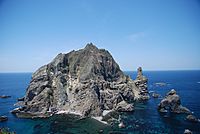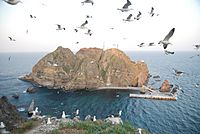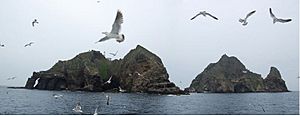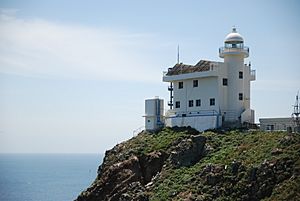Liancourt Rocks facts for kids
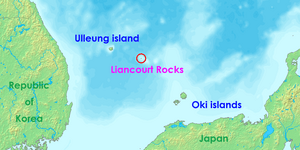
Location of the Liancourt Rocks in the Sea of Japan between Japan and South Korea
|
|
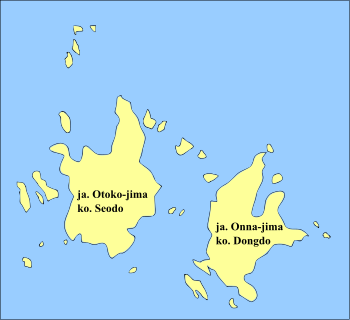 |
|
| Geography | |
|---|---|
| Location | Sea of Japan |
| Coordinates | 37°14′30″N 131°52′0″E / 37.24167°N 131.86667°E |
| Total islands | 91 (37 permanent land) |
| Major islands | East Islet, West Islet |
| Area | 18.745 ha (46.32 acres) East Islet: 7.33 hectares (18.1 acres) West Islet: 8.864 hectares (21.90 acres) |
| Highest elevation | 169 m (554 ft) |
| Highest point | West Islet |
| Administration | |
| County | Ulleung County, North Gyeongsang |
| Town | Okinoshima, Shimane (Japan) |
| Demographics | |
| Population | Approximately 34 |
The Liancourt Rocks are a group of small islets in the Sea of Japan. They are located between the Korean peninsula and Japan. These islets are also known as Dokdo in Korean and Takeshima in Japanese.
South Korea currently manages the Liancourt Rocks. However, both Japan and North Korea also claim them as their own. This means there is a disagreement about who truly owns these islands.
The Liancourt Rocks are made up of two main islets and 35 smaller rocks. The total area of all the islets is about 0.187554 square kilometers (0.072 square miles). The highest point is 168.5 meters (553 feet) tall and is found on the West Islet. The waters around the Liancourt Rocks are good for fishing. They might also have large amounts of natural gas hidden beneath the sea.
The English name Liancourt Rocks comes from a French whaling ship called Le Liancourt. This ship almost crashed on the rocks in 1849. The sailors on the ship then made a map of the islets.
Contents
Geography of the Islets
The Liancourt Rocks include two main islets and many smaller rocks around them. The two main islets are called Seodo (Western Island) and Dongdo (Eastern Island) in Korean. In Japanese, they are called Ojima (Male Island) and Mejima (Female Island). These two main islets are about 151 meters (495 feet) apart.
The Western Island is larger and taller than the Eastern Island. However, the Eastern Island has more flat space that people can use. In total, there are about 90 islets and reefs. These are volcanic rocks that formed millions of years ago. About 37 of these islets are considered permanent land.
The total area of all the islets is about 187,554 square meters (46.3 acres). The highest point is on the West Islet, at 168.5 meters (553 feet). The Western Islet has one main peak and many caves along its coast. The cliffs of the Eastern Islet are about 10 to 20 meters (33 to 66 feet) high. It also has two large caves that open to the sea and a crater.
Scientists reported in 2006 that the islets formed 4.5 million years ago. They are slowly wearing away due to natural forces.
Visiting the Liancourt Rocks
People can visit the Liancourt Rocks by taking a ferry from Ulleung Island. In 2022, more than 280,000 tourists visited the islands. This means about 500 visitors came each day.
Distances to Other Lands
The Liancourt Rocks are located at about 37°14′N 131°52′E. The Western Islet is at 37°14′31″N 131°51′55″E, and the Eastern Islet is at 37°14′27″N 131°52′10″E.
The rocks are about 211 kilometers (131 miles) from the main island of Japan (Honshu). They are about 216.8 kilometers (134.7 miles) from mainland South Korea. The closest Japanese island, Oki Islands, is 157 kilometers (98 miles) away. The closest Korean island, Ulleungdo, is 87.4 kilometers (54.3 miles) away.
Climate and Weather
The Liancourt Rocks can have very strong weather because of their location and small size. If the ocean waves are higher than 3 to 5 meters (10 to 16 feet), ferries cannot land. This means ferries can only dock about once every 40 days on average.
The climate is generally warm and humid. It is greatly affected by warm ocean currents. There is a lot of rain throughout the year, with an average of 1383.4 millimeters (54.5 inches) annually. Sometimes it snows. Fog is also common. In the summer, winds mostly come from the south. The water around the islets is coldest in early spring, around 10°C (50°F). It warms up to about 24°C (75°F) in late summer.
Plant and Animal Life
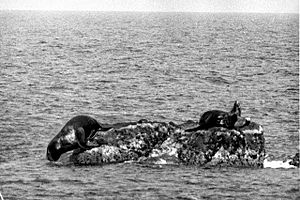
The islets are made of volcanic rocks and have only a thin layer of soil and moss. Scientists have found about 49 types of plants, 107 types of birds, and 93 types of insects living on the islets. The marine life around the islands includes 160 types of algae and 368 types of invertebrates (animals without backbones).
Even though 1,100 to 1,200 liters (290 to 317 gallons) of fresh water flow daily, special plants have been built to make drinking water for people. This is because the natural spring water can be dirty from bird droppings. Since the early 1970s, trees and some flowers have been planted.
Historically, there were native trees on the Liancourt Rocks. These trees are thought to have been lost due to too much harvesting and fires from bombing drills. However, a recent study found ten spindle trees that are 100 to 120 years old. Large sea animals like Minke whales, orcas (killer whales), and dolphins are known to travel through these waters.
Pollution Concerns
There are worries about pollution in the seas around the Liancourt Rocks. The system that cleans sewage water on the islets has not worked well. This means sewage from the people living there, like the South Korean Coast Guards and lighthouse staff, has been dumped directly into the ocean.
This pollution has caused problems. The seawater has turned milky white, and sea plants are dying. Coral reefs are also becoming calcified, which means they are hardening and dying. This pollution is also causing a loss of different kinds of plants and animals in the surrounding seas. In 2004, about eight tons of smelly waste were being dumped into the ocean every day. Since then, groups have worked to reduce the pollution around the Rocks.
Buildings and Facilities
South Korea has built several structures on the Liancourt Rocks. By 2009, the islands had a lighthouse, a place for helicopters to land, and a police station. In 2007, two desalination plants were built. These plants can produce 28 tons of clean water every day. Both of South Korea's main phone companies have also put up cell phone towers on the islets.
History and People
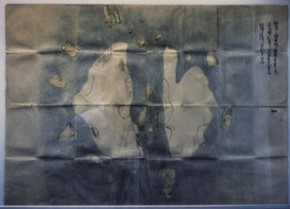
Whaling History
Between 1849 and 1892, American and French whaleships hunted right whales near the rocks.
Who Lives There
In February 2017, about 34 people lived on the islets. This included two regular citizens, two government workers, six lighthouse managers, and 40 members of the coast guard. Since the South Korean coast guard arrived, regular people need permission from the South Korean government to visit. This is because the islets are a nature reserve.
In 1965, a man named Choi Jong-duk moved to the islets from nearby Ulleungdo to fish. He was the first person to officially live there, changing his address in 1981. He passed away there in 1987. His son-in-law and his wife also lived there for a few years. In 1991, Kim Sung-do and Kim Shin-yeol became permanent residents. Kim Sung-do passed away in 2018, leaving Kim Shin-yeol as the last civilian living on the islands.
The South Korean government allowed 1,597 visitors in 2004. Since March 2005, more tourists have been allowed to visit. The government lets up to 70 tourists land at one time. One ferry provides trips to the islets every day. Tour companies charge about 350,000 Korean won per person, which was about US$310 in 2019.
Sovereignty Dispute
The ownership of the Liancourt Rocks is a long-standing disagreement between Japan and South Korea. Both countries have different ideas about who historically owned the islets.
South Korea's claims are partly based on old records, maps, and encyclopedias that mention an island called Usan-do. South Korea believes these old writings refer to today's Liancourt Rocks. However, Japanese researchers say that Usan-do in these old documents might refer to other islands, or even an island that doesn't exist. The name Dokdo was first written in a Japanese log book in 1904.
Both North Korea and South Korea agree that the islands belong to them. They both reject Japan's claim to the territory.
Natural Monument of South Korea
The Liancourt Rocks are important for nature. They were named a Natural Monument of South Korea (number 336) on November 29, 1982. This was because they are a breeding ground for certain birds, including band-rumped storm petrels, streaked shearwaters, and black-tailed gulls.
See also
In Spanish: Rocas de Liancourt para niños


